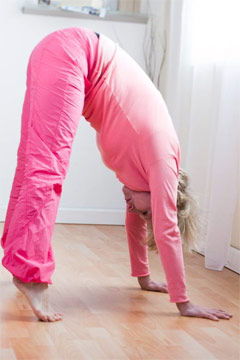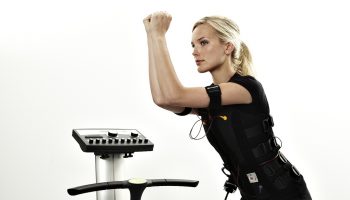The Five Tibetan Rites is a system of exercises reported to be more than 2,500 years old which were first publicized by Peter Kelder in a 1939 publication titled The Eye of Revelation. According to the lamas there are seven spinning, “psychic vortexes” within the body: two in the brain, one at the base of the throat, one on the right side of the body in the vicinity of the liver, one in the reproductive anatomy, and one in each knee. As we grow older, the spin rate of the vortexes diminishes, resulting in “ill-health”.
My daily morning routine is the 5 Tibetans. It’s an ancient yoga practice that contains 5 stretching and strengthening exercises. Irina Jenni, kite surfer
However, the spin rate of these vortexes can be restored by performing the Five Rites (asanas) daily, resulting in improved health.

1.Whirling Dervish
The first of the five Tibetans is a standing exercise. To perform this exercise, stand up straight with your arms held out to your sides at shoulder height. Spin from left to the right and keep looking forward. Let your vision blur as you spin. Breathe deeply into your abdomen. Slowly work up to 21 spins.
Significance: best for balance mechanism
2.Tibetan leg lifts
To begin the second of the five Tibetans, lie on your back with your legs straight and your arms at your sides. Fingers should be kept close together with the finger-tips of each hand turned slightly toward one another. Touch your legs together. Inhale as you lift your legs until they are perpendicular with the floor. Do not let the knees bend. Raise your head off the floor at the same time, bringing your chin toward your chest. Exhale as you lower your head and legs back to the floor. Work up to 21 leg raises.
Significance: Best for Digestion and Elimination
3. The Tibetan Camel
The third of the five Tibetans promotes flexibility of the spine and gently stretches the back, chest, abdomen and neck. To perform the exercise, kneel on the floor and relax your arms against your sides. Your back is straight with your hips, shoulders and knees in line. First, exhale and bend your chin toward your chest. Then, inhale as you bend your head back to look up and you gently arch your lower back. Slide your hands up to your lower back as you bend backwards. The posture resembles the camel in yoga. Repeat up to 21 times.
Significance: opening up lungs
4. Staff to Upward Plank Pose
The fourth Tibetan combines two popular yoga postures, the staff pose and a variation of upward plank pose. To begin, sit with your legs together and straight in front of you. Place your hands on the floor next to your buttocks with your fingers pointing forward and flex your feet toward your shins. This is staff pose. Inhale as you bend your knees and raise your hips off the floor. Lift up until your spine is parallel to the floor and your knees are in line with your ankles. Look at the ceiling. Exhale as you lower back into staff pose. Perform up to 21 repetitions.
Significance: strengthening of arms, legs and back; enhances respiration and circulation.
5. The Fifth Rite

To begin, assume push-up position with your hands shoulder-width apart. Inhale and press your hips up toward the ceiling. Your arms and legs are straight. Push your heels down and align your neck with your spine. Next, exhale as you lower your hips and arch your back. Lift your chest to face forward as you tilt your head to look up. Your hips are inches from the floor and your arms are straight. The muscles should be tensed for a moment when the body is at the highest point, and again at the lowest point. Perform up to 21 reps.
Significance: strengthening the entire body
The benefits most likely to be achieved by regular practice of these rites are increased energy, stress reduction, and an enhanced sense of calm, clarity of thought, increased strength and flexibility, resulting in an overall improvement in health and well-being.
Disclaimer
The Content is not intended to be a substitute for professional medical advice, diagnosis, or treatment. Always seek the advice of your physician or other qualified health provider with any questions you may have regarding a medical condition.
